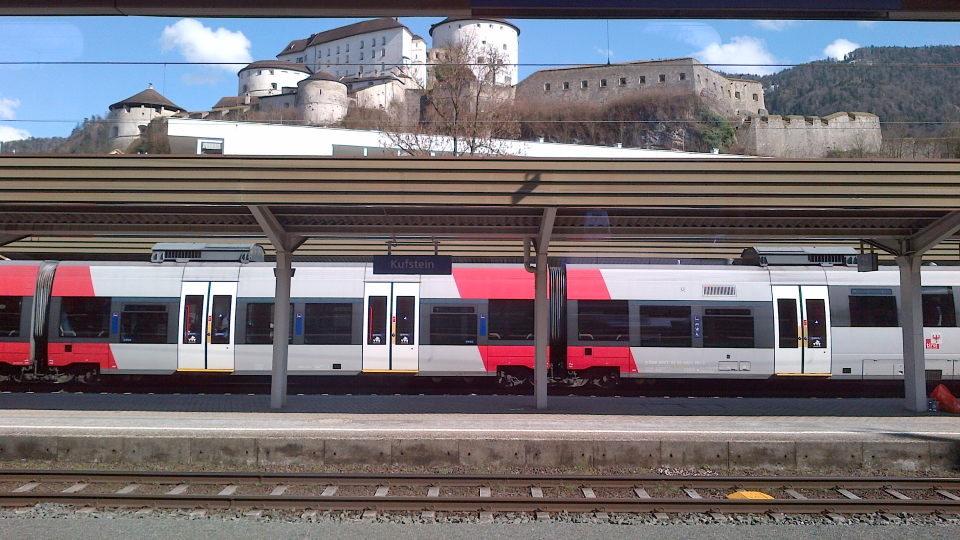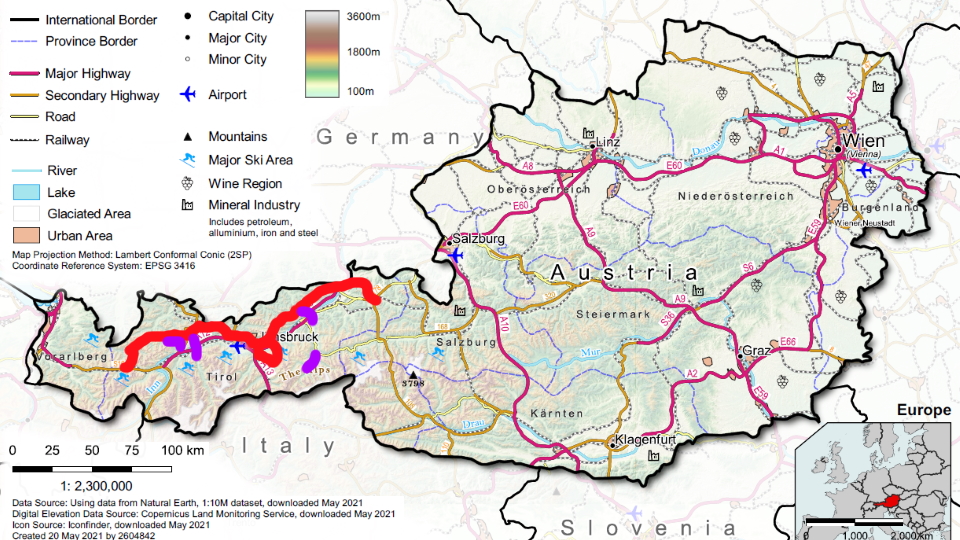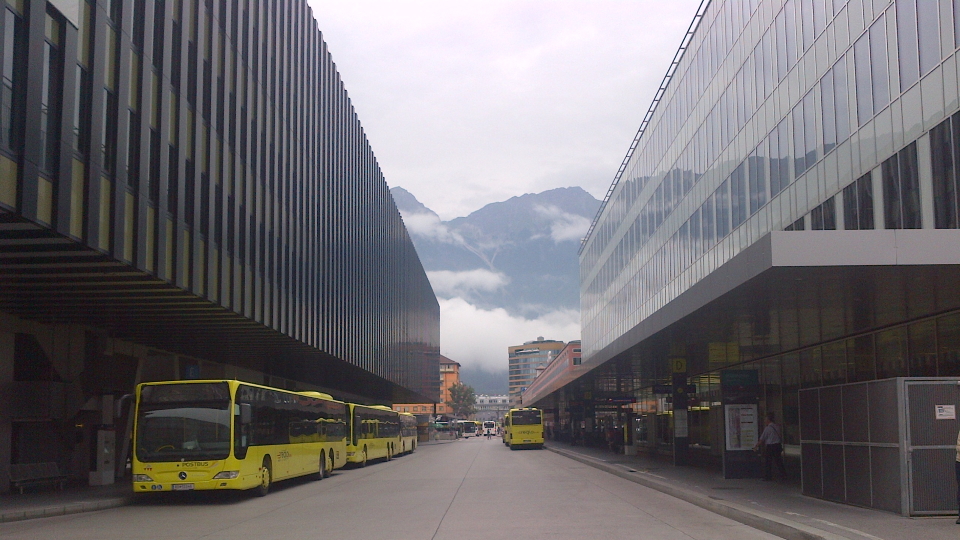Travel in Austria: Trains, buses and suggestions
We will not be exhaustive - a tricky feat in a country as large and intricate as Austria - but instead we will suggest the routes that we have enjoyed. This is in the context of exploring Europe before or after a mountain hike. This will be a personal view by me Simon and my colleage Hannah.
|
|
I first visited Austria in July 2000, on route from Munich to the Dolomites. (A personal view by Simon Stevens.) I was traveling to meet two friends in Madonna-in-Campiglio, then to drive to Corvara for some via ferrata, the famous fixed steps and cables on the Dolomite hills. It was clear that I would be driving across the Tyrol, specifically at the famous Brenner Pass to the South of Innsbruck. I stayed a night in a small village in the Stubai valley.
I was very pleased to experience the situation of Munich and its enormous airport, in relation to Innsbruck and this section of the Alps. It is a region quite distinct culturally and geographically from the French and Swiss Alps out of Geneva.
We wanted to add an Austrian itinerary to our programme. At about the right time, which for us was 2014, the Tyrol tourist board began to promote a route called the Adlerweg (Eagle's Way in German), East to West across the Tyrol. I skiied two separate weeks in Austria, first in Schladming (not in the Tyrol) and then at Kitzbuel which is a train ride from St. Johann. We continue to apply the principle that visits across the seasons allow a broad perspective on towns, mountains and travel routes, and I remember a distinct feeling of adventure as our train pulled into St. Johann on its way from Schladming to Innsbruck, snow on the ground all around, before I had made one step on the Adlerweg.
It happens that the Adlerweg was the first Alpine Exploratory trip wholly to be researched using trains and buses, without visits by car. This was the time, 2014, when we revised our mode of exploration fully to reflect our hikers' approaches, unlikely to involve hire cars and instead to be on the train. We became regulars on the Munich-Innsbruck railway.
Without the internationally famous mountain train routes of Switzerland, much of Austria's appeal lies in the passing through, or in the chance finds in the numerous side valleys. The bus coverage of the country is excellent in its breadth and it is here we look first:
Pinegg to Rattenberg 
5/5 stars 35 minutes
Mountainous through-route
From Pinegg to Rattenberg
This is unexpected, surely some of the most fabulous gorge scenery - we have seen more spectacular in Switzerland but only just - to be found in Europe. Pinegg is a tiny village, really a collection of farms and a guesthouse, that happens to be on the Adlerweg. Walkers stay local to Pinegg and only those who were staying in the main valley at Rattenberg or other towns, would see the gorge. (It happens this way on a couple of our other treks, for example the West Highland Way and the Via Alpina (Switzerland), so please ask us about these off-route splendours!) Of course if you were to join the Adlerweg at Pinegg then you'd take this bus route, and we like to suggest this approach to our clients with 4 days to trek. Four stages puts them around Innsbruck and involves 2 mountain huts. Back to the gorge, sit on the right of the bus as you descend to Rattenberg and look out. Later across the open fields of Brandenburg, on its sunny shelf, all seems right with the world. Rattenberg itself is a charming old town with a winding street and bars.
Mayrhofen to Schlegeis Stausee 
4/5 stars 50 minutes
Mountainous out-and-back
From Mayrhofen to Schlegeis Stausee
A trip to the head of the valley! This is the major walker's bus route from the notable and agreeable base of Mayrhofen. We reach Mayrhofen by the branch line from Jenbach and everything is delightful. The bus up to the lake, the Schlegeis, can get busy. It heads through the valley and climbs hairpins beyond Ginzling. From the lake, mountains loom all around; there is an easier walk to the Italian border but the trails on the hillsides are rocky and rough. We are right on the Zillertaler (Berliner) high route.
Ehrwald to Nassereith over the Fernpass 
4/5 stars 30 minutes
Mountainous through-route
From Ehrwald to Nassereith
In fact this pass, the Fernpass, is a major road crossing of the spine of the Alps, a popular link between Germany and Austria. The Fernpass is not a mountainous one, as they go. On the way down we see the Fernsteinsee and it is at this little lake that the Adlerweg leaves for the mountains, destination Lechtal.
Imst to Elmen via Bschlabs 
4/5 stars 1 hour
Mountainous through-route
From Imst to Elmen
Shadowing the Adlerweg into the Lechtal, this hilly route also takes us within a modest walk of the Anhalter hutte and is our quick route to this hut if needed. This is intricate Austria, in places hidden and local, beautiful yet not touristy.
Linking Austria's dispersed cities are a few classic long-distance routes and you might find that your journey hops on and off a number of these routes. For example, heading to Klagenfurt or Graz you might change at Salzburg and then Bischofshofen depending on the timings of trains.
Zurich to Innsbruck and Vienna 
4/5 stars 4h 15m from Innbsruck to Vienna
Zooming to Vienna after the Adlerweg is quite simple thanks to the regular, comfy express trains sometimes in the livery of 'railjet'. These go via Salzburg and Linz. There is a lot of rolling farmland after Salzburg, as we skirt to the North of the hills in the East of Austria. In fact the best scenery is between Worgl and Salzburg where some trains take to the smaller line that winds around several ski resorts: Zell am See, Kitzbuel and more. This is a mini retrospective on the Adlerweg.
Innsbruck to Graz 
4/5 stars 6 hours from Innsbruck to Graz
Turning to the South at Salzburg, we wind through deep gorges, too deep to be immediately attractive. We might change trains at Bischofshofen, and then begins a winding exploration of the Styria region. This is solid farming territory, forests above, middle-size mountains above that. Graz is Austria's second city by population and is not widely known but has a fabulous castle-belvedere looking down on town, trams, and good coffee and evening buzz. From Graz take the train on to Vienna. Similar to Graz and a little smaller, with attached lake, is Klagenfurt.
Austria is not notable for the immense mountain railways of some parts of the Alps (meaning Switzerland) but it has some. The mountains are in the 3,000m range instead of 4,000m and there are fewer high ski stations to reach. We love the cross-country nature of Austrian travel and we regard it as at least as enjoyable for mountain travel as any other country.
Worgl to Salzburg via Zell am See 
4/5 stars 3 hours
Rolling cross-country line
From Worgl to Salzburg
This is the mountainous portion of many cross-Austria rail routes, leaving the Inn valley at the interchange station of Worgl and heading into the hills. We pass Kirchberg, Kitzbuel, St. Johann in Tyrol (start of the Adlerweg) and then down in the valley Zell am See. The glacier above is the Kaprun ski area. Reaching the main lines again at Bischofshofen, the train zooms North into Salzburg. This one trip covers a great portion of Austria and is ideal when linking Innsbruck and Salzburg to contine your explorations.
Jenbach to Maurach on the Achensee 
3/5 stars 26 minutes
Mountainous up-and-down
From Jenbach to Maurach
An old engine climbs this steep cog railway, making an alternative to the bus route up the hill to Maurach. This pleasant lake not-quite-side village is on the Adlerweg and has mountains and huts on either side.
The other end of Austria, on the plains and facing the East, Vienna is a world away from the Tyrol. Austria is such a long country East to West and in the middle are a thousand separate valleys. Nevertheless, a stay in Vienna after the Alps will sharpen your feeling for Austria and will be entertaining in its own right. We love Vienna and like to recommend it. (We especially love Bern and Vienna.)
Walk around Vienna after the Tyrol and you will appreciate the real Austria; the one that Vienna-only tourists, who are a very large part of the market, cannot. The street signs and the cultural icons in the cafes and shops are those that you have met in the mountains on a smaller scale, and equally Austrian. We would always recommend the mountains and capital city combination.
So to Vienna itself, and what will we find on the streets? The scale of the city is immediately apparent, on a level with Munich and not far from the size of London. There is a feeling of being at the centre of an empire. Tourists need stay only within the first ring of streets, though that's a mistake of course; there is a secondary ring extending miles, of mid-rise apartments in elaborate design, and then an outer ring road, and then many miles of Vienna beyond. We don't need to (again we want to) venture North over the river to the Prater park and famous ferris wheel (movie: Beyond Sunrise).
Tourism is centred on the massive St Stephen's church and surrounding theatres and palaces. Vienna is Mozart's birthplace. There is a tram network, plus a whole subway network, as well as buses and local trains. The tram and subway are ample to get about the inner Vienna, to the university area (ask for our coffee recommendations - not just the grand old cafes) and to various interesting residential areas. Shopping extends all the way from the city centre along Mariahielfenstrasse to the Westbahnhof, one of three main stations, the others being Hauptbahnhof and Wien Mitte. Indeed, Vienna's name is really Wien.
You might be wondering how to recreate the Tyrolean charm of bars and restaurants, without the tourists, and in the very middle of town it's hard. Again please ask us, and see our basic notes on Vienna on our Adlerweg trips.
Usual post-mountain rules apply: don't force the busy urbanism, because it can be too much by contrast, but instead explore slowly and widely and let the scenery build up a picture.
Suppose you will be in Austria after a trek and want to see a broader swathe of the country itself. Head back East to Vienna by a longer route. The direct train to Vienna, from say Innsbruck or St. Anton, takes about 4-5 hours and goes via the bigger (still small) Austrian city of Linz. Try this plan:
In 3 nights from St. Anton:
Day 1 Train from St. Anton to Salzburg, via Innsbruck (Stay in Salzburg)
Day 2 Train from Salzburg to Graz (Stay in Graz)
Day 3 Train from Graz to Vienna (Stay in Vienna)
Day 4 Fly from Vienna
Switzerland
Now let's look at a finish in the West of Austria, for example at St. Anton after hiking the Adlerweg. You could explore Austria for several more weeks, if you had time. Following your bold East-West trajectory, however, once at St. Anton you could jump on the train towards Zurich. Get off at Sargans, which is a pleasant example of a mildly historic working Swiss town, and change for Chur, to give yourself many options for the famous scenic rail lines.
In 3 nights from St. Anton (Austria):
Day 1 Train from St. Anton to Sargans (Switzerland) and Chur (Stay in Chur)
Day 2 Train from Chur to Zermatt (Glacier Express) (Stay in Zermatt)
Day 3 Train from Zermatt to Bern, via Klagenfurt (Stay in Bern)
Day 4 Train from Bern to Zurich and fly.
 Travel in Switzerland Please see our equivalent page about Swiss travel
Travel in Switzerland Please see our equivalent page about Swiss travel
Vienna is so pre-eminent within Austria, in a way that (for example) no one Swiss city is within Switzerland. After Vienna it is possible to appreciate Austria in a lower-key way at Graz, Klagenfurt, Salzburg and Innsbruck. It is by no means necessary to see Salzburg ahead of these other cities, despite its fame. After Vienna we have had most fun in Graz and Innsbruck. We have written more about the main cities on the Alpine fringe:
 Travel in the Alps: Cities
Travel in the Alps: Cities
Flying to Austria
Vienna is not at all the handiest airport for this end of the Alps; instead try Munich, for Innsbruck, and first have a go at Innsbruck itself. It is mainly a ski airport but there are Summer flights from London airports and Frankfurt among others.
Indeed from the end of our Adlerweg at St. Anton, it is easy to take the mainline train to Zurich, and once at Zurich to reach Basel or Geneva. With time, it is possible to see a lot of Europe.
If flying to one of Austria's regional airports - Salzburg, Graz, Klagenfurt, as well as Innsbruck - you'll find that connections tend to be through Frankfurt, not Vienna as would be expected. They used to be, but Austrian Airlines was bought by Lufthansa and the regional hub of Vienna was abandoned and amalgamated into Frankfurt. It is a smooth service with connections maintained as much as possible. Land at Frankfurt and you'll see the Austrian section with small planes waiting to fly out.
Travel within Austria is one of the secrets of Europe, in our view: as good as Switzerland but very much less expensive. Apart from a couple of particular lines in Switzerland, in Austria the mountains-all-around are just as scenic. The organisation is just as impressive.
A simple example: even the tiniest bus stop in the most remote area is a named stop and can be searched on the Austrian trains website www.oebb.at. For example, put in Innsbruck to Pinegg and it will show the combination of train and bus needed. There is no need to search through local bus companies and their un-updated timetables. This ease of finding bus times has simplified for us several complicated days of travel.
Austrian travel is about as simplified as it is possible to imagine, even beating the Swiss in this regard. However, it is inevitable that some local situations will lead to intricacies that are not obvious at first glance. These tend to happen, and I'm sure this applies worldwide, where the relative position of villages leads buses to run a particular route with out-and-backs and splits and pauses, or where the topographical situation is not what we would expect.
The Achensee
The Achensee is the large lake in between the Rofan and the Karwendel mountain ranges, and a stop on the Adlerweg. Buses run to Pertisau on one shore and then back and up the other shore away from the hills. Look closely at the destinations on each bus!
Munich trains to Kufstein
From Munich into the Alps, two train companies operate the key route to Kufstein: the blue Meridian trains which are a newer style with bike and ski space, and the traditional loco-hauled OBB or DB trains with many carriages. Tickets are not comaptible with the other trains, so attention is needed to the time and the type of train you are aiming for.
Summer closures
Each Summer in Austria there is a period of maintenance, this not being possible in the Winter months. It tends to be held in August or July and it is well advertised in advance, with bus replacements locally signed at stations and stops. It lasts for 3 or 4 weeks. It is typical to see a village's bus station populated by rail replacement coaches that look ad-hoc, as well as the normal yellow buses on their regular routes. We aim to advise our hikers each Summer on routes that might apply to their trail, as part of our pre-season recces and our Season Update.
Austrian trains and buses are at least as well-organised as the Swiss and offer at least as comprehensive a coverage of the country, and at a much lower price. Heading East within Austria we appreciate its Central European situation and the ease of land travel across the open spaces to the East of the Alps. There is real romance here.
Please chat with us
At Alpine Exploratory we love questions about wider Austrian, Alpine or European travel after a hike. As we research our trails, we look to the side to the context of the country. Please ask us about your plans. Thank you.
 Contact us
Contact us
 Holiday Schedule
Holiday Schedule
 Travel - our main page for these travel aspects
Travel - our main page for these travel aspects

Alpine Exploratory
Alpine Exploratory is a system of knowledge on the best mountain trekking in our areas, giving clients superb holidays based on this exploration.
About us
 02 8319 2266 from Australia
02 8319 2266 from Australia 416-548-4819 from Canada
416-548-4819 from Canada 04 889 4515 from New Zealand
04 889 4515 from New Zealand 646-757-1102 from the USA
646-757-1102 from the USA







 A red, white and silver train waits at Kufstein station
A red, white and silver train waits at Kufstein station













 Alpine Exploratory
Alpine Exploratory
 +44 (0)131 214 1144
+44 (0)131 214 1144
